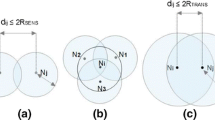Abstract
In this paper, an algorithm is proposed to optimize the network connectivity efficiency of a network with nodes of different energy harvesting rates by using the fewest RNs while ensuring a high success rate of data transmission. The algorithm calculates the weight of each node based on the energy harvesting capacity and then uses it to calculate the edge weight. Next, based on the edge weight, the Kruskal algorithm is used to create a minimum spanning tree (MST). Finally, the quantity of non-leaf nodes of the MST is inspected to verify that it meets the transmission requirements for data flow. If not, such nodes will be deemed as nodes with a low energy capacity. The support of RNs is required for these nodes to guarantee network connectivity. As shown by experimental data, the algorithm can be used to maintain network connectivity with the fewest RNs, which reduces the cost and increases the transmission success rate of data packages.









Similar content being viewed by others
Change history
14 February 2024
This article has been retracted. Please see the Retraction Notice for more detail: https://doi.org/10.1007/s11227-024-05972-7
References
Butun I, Morgera SD, Sankar R (2014) A survey of intrusion detection systems in wireless sensor networks. IEEE Commun Surv Tutor 16(1):266–282
Xie S, Wang Y (2014) Construction of tree network with limited delivery latency in homogeneous wireless sensor networks. Wirel Pers Commun 78(1):231–246
Chen KC, Lien SY (2014) Machine-to-machine communications: technologies and challenges. Ad Hoc Netw 18(3):3–23
Al-Hamadi H, Chen IR (2014) Redundancy management of multipath routing for intrusion tolerance in heterogeneous wireless sensor networks. Int J Res Comput Appl Robot 2(6):189–203
Singh SP, Sharma SC (2014) A survey on cluster based routing protocols in wireless sensor networks. J Appl Sci 45(18):687–695
Bhuiyan MZA, Cao J, Wang G (2015) Deploying wireless sensor networks with fault tolerance for structural health monitoring. IEEE Trans Comput 64(2):382–395
Ojha T, Misra S, Raghuwanshi NS (2015) Wireless sensor networks for agriculture: the state-of-the-art in practice and future challenges. Comput Electron Agric 118(3):66–84
Shamshirband S, Amini A, Anuar NB et al (2014) D-FICCA: a density-based fuzzy imperialist competitive clustering algorithm for intrusion detection in wireless sensor networks. Measurement 55(9):212–226
Shamshirband S, Anuar NB, Kiah MLM et al (2014) Co-FAIS: cooperative fuzzy artificial immune system for detecting intrusion in wireless sensor networks. J Netw Comput Appl 2014(42):102–117
Razaque A, Elleithy KM (2014) Energy-efficient boarder node medium access control protocol for wireless sensor networks. Sensors 14(3):5074–5117
Rosário D, Zhao Z, Santos A et al (2014) A beaconless opportunistic routing based on a cross-layer approach for efficient video dissemination in mobile multimedia IoT applications. Comput Commun 45(1):21–31
Narudin FA, Feizollah A, Anuar NB et al (2016) Evaluation of machine learning classifiers for mobile malware detection. Soft Comput 20(1):1–15
Ma J, Lou W, Li XY (2014) Contiguous link scheduling for data aggregation in wireless sensor networks. IEEE Trans Parallel Distrib Syst 25(7):1691–1701
Liu C, Arunkumar N (2018) Risk prediction and evaluation of transnational transmission of financial crisis based on complex network. Clust Comput. https://doi.org/10.1007/s10586-018-1870-3
Meng G, Arunkumar N (2018) Construction of employee training program evaluation system of three exponential forecast based on sliding window. Clust Comput. https://doi.org/10.1007/s10586-017-1652-3
Chen X, Pang L, Guo P, Sun X, Xue Z, Arunkumar N (2017) New upper degree of freedom in transmission system based on wireless G-MIMO communication channel. Clust Comput. https://doi.org/10.1007/s10586-017-1513-0
Hamza R, Muhammad K, Nachiappan A, González GR (2017) Hash based encryption for keyframes of diagnostic hysteroscopy. IEEE Access. https://doi.org/10.1109/ACCESS.2017.2762405
Wei J, Meng F, Arunkumar N (2018) A personalized authoritative user-based recommendation for social tagging. Future Gener Comput Syst. https://doi.org/10.1016/j.future.2018.03.048
Ashokkumar P, Arunkumar N, Don S (2018) Intelligent optimal route recommendation among heterogeneous objects with keywords. Comput Electr Eng 68:526–535
Hussein AF, Kumar A, Burbano-Fernandez M, Ramirez-Gonzalez G, Abdulhay E, de Albuquerque VHC (2018) An automated remote cloud-based heart rate variability monitoring system. IEEE Access. https://doi.org/10.1109/ACCESS.2018.2831209
Sarvaghad-Moghaddam M, Orouji AA, Ramezani Z, Elhoseny M, Farouk A, Arun Kumar N (2018) Modelling the spice parameters of SOI MOSFET using a combinational algorithm. Clust Comput. https://doi.org/10.1007/s10586-018-2289-6
Elhoseny M, Ramírez-González G, Abu-Elnasr OM, Shawkat SA, Arunkumar N, Farouk A (2018) Secure medical data transmission model for IoT-based healthcare systems. IEEE Access. https://doi.org/10.1109/ACCESS.2018.2817615
Mohammed MA, Ghani MKA, Arunkumar N, Hamed RI, Mostafa SA, Abdullah MK, Burhanuddin MA (2018) Decision support system for nasopharyngeal carcinoma discrimination from endoscopic images using artificial neural network. J Supercomput. https://doi.org/10.1007/s11227-018-2495-2
Mohammed MA, Ghani MKA, Arunkumar N, Hamed RI, Abdullah MK, Burhanuddin MA (2018) A real time computer aided object detection of nasopharyngeal carcinoma using genetic algorithm and artificial neural network based on Haar feature fear. Future Gener Comput Syst. https://doi.org/10.1016/j.future.2018.07.022
Mohammed MA, Ghani MKA, Arunkumar N, Obaid OI, Mostafa SA, Jaber MM, Burhanuddin MA, Matar BM, Abdullatif SK, Ibrahim DA (2018) Genetic case-based reasoning for improved mobile phone faults diagnosis. Comput Electr Eng. https://doi.org/10.1016/j.compeleceng.2018.07.053
Mutlag AA, Ghani MKA, Arunkumar N, Mohamed MA, Mohd O (2018) Enabling technologies for fog computing in healthcare IoT systems. Future Gener Comput Syst. https://doi.org/10.1016/j.future.2018.07.049
Mohammed MA, Ghani MKA, Arunkumar N, Mostafa SA, Abdullah MK, Burhanuddin MA (2018) Trainable model for segmenting and identifying Nasopharyngeal carcinoma. Comput Electr Eng. https://doi.org/10.1016/j.compeleceng.2018.07.044
Acknowledgements
Funding was received from the National Natural Foundation of China under Grant No. 60673185 and from the Jiangsu Future Network Prospective Research Fund Project (BY2013095-4-09).
Author information
Authors and Affiliations
Corresponding author
Additional information
This article has been retracted. Please see the retraction notice for more detail: https://doi.org/10.1007/s11227-024-05972-7"
Rights and permissions
Springer Nature or its licensor (e.g. a society or other partner) holds exclusive rights to this article under a publishing agreement with the author(s) or other rightsholder(s); author self-archiving of the accepted manuscript version of this article is solely governed by the terms of such publishing agreement and applicable law.
About this article
Cite this article
Weizheng, L., Xiumei, T. RETRACTED ARTICLE: Quality analysis of multi-sensor intrusion detection node deployment in homogeneous wireless sensor networks. J Supercomput 76, 1331–1341 (2020). https://doi.org/10.1007/s11227-018-2574-4
Published:
Issue Date:
DOI: https://doi.org/10.1007/s11227-018-2574-4




